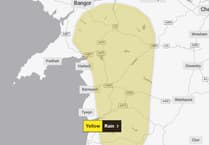Making Ceredigion a net zero carbon county by 2050 would cost a total of £2.4 billion and require all homes to replace fossil fuel heating systems in order to meet the target, a fresh report outlines.
A report put before Ceredigion County Council’s Cabinet members on Tuesday, 14 May outlines the aims of Ceredigion’s Local Area Energy Plan which contains ambitious targets to achieve the council’s net zero carbon aims by 2050.
The report says that £654m in funding will be needed “over business-as-usual investment” to reach the target.
That figure is on top of an expected £1.7bn investment towards net zero aims, with the plan outlining the amount of cash it will take to transform each area of the county to reach net zero – broken down into 11 zones in the plan.
The report outlines that Aberystwyth Central area will need £385m with Aberystwyth East requiring £123m.
Llanrhystud will need £160m of investment with Aberaeron at £248m and Aberporth at £302m.
Cardigan area will need £213m, New Quay £346m and Lampeter £167m.
Tregaron will need investment of £139m, with Devils Bridge needing £95m and Borth £232m.
The report says the cost to the county would be more than the outlay if a “do nothing” approach was adopted instead of making the changes.
Examples of “priority projects” early on in the plan include a £145.5m heat network in Aberystwyth, and more than £11m spent to upgrade insulation and heating systems and install solar panels on hundreds of social housing homes in Lampeter, Cardigan and Aberystwyth.
The plan wants to install 29,500 heat pump systems in homes throughout Ceredigion, with 1,500 homes connected to a district heat network, and 23,700 retrofitted with insulation.
It also calls for at least a third of homes to be generating their own electricity with rooftop solar panels.
The estimated 6,400 static caravans in Ceredigion will also need to switch from gas heating to fully electric, the report said.
The plan also estimates a total of 32,200 fully electric vehicles in Ceredigion by the target date and puts plans in place to drastically increase EV charging points in the county.
Currently just 28 per cent of homes in Ceredigion are fully insulated, with 28 per cent also currently using low carbon heating.
Just one per cent of cars are low carbon, with 490 electric vehicles registered in Ceredigion.
Currently around five per cent of homes have solar panels, and while it that is one of the highest percentages in Wales it lags far behind the target outlined in the plan.
The council has also called for planning restrictions on heat pump heating systems installation to be relaxed to encourage take up, with current regulations stringent on size and positioning.
Along with replacing petrol and diesel cars with electric vehicles the plan calls for a major increase in the availability of public transport options in the county.
The report says that “100 per cent of homes in Ceredigion currently using fossil fuel heating will need to be converted to low carbon heating systems to reach net zero by 2050.”
“Air source heat pumps are the most widely suitable low carbon heating technology for homes in Ceredigion, so are expected to be the predominant solution, installed in 76 per cent of homes by 2050,” the report adds.
In March 2020 Ceredigion County Council was one of several in Wales to declare a climate emergency in March 2020 and pledged to make Ceredigion a Net Zero carbon local authority by 2030.
The county is, however, not likely to hit an interim carbon target of a 63 per cent reduction on 1990 baseline by 2030.
The plan “identifies that it is possible to achieve a net zero energy system in Ceredigion by 2050” but warns targets may easily be missed as it is “highly dependent on financial and technical support, policy changes, supply chain development, addressing current skills gaps and behavioural changes.”
“There is a risk that interim carbon targets could be missed,” the report adds.
“For example, the installation rates of heat pumps, insulation and other low carbon changes required by 2030 will be extremely challenging to deliver given the time it takes to scale up supply chains and skilled personnel.
“In addition, any delays in network investment would result in interim carbon targets, and potentially the 2050 target, being missed in Ceredigion, highlighting the criticality of investment in the grid.”
“Climate change is one of the greatest threats to both food security and biodiversity, suggesting that rapid decarbonisation is one of the most important measures to protect agriculture and the living world,” the report adds.
The report says the plan “details the scale and rate of change required to transition the local energy system to net zero by 2050” but that there are “no direct financial implications at this stage.”
“In addition to ongoing support from the Welsh Government Energy Service, Welsh Government has provided grant funding for Regional Energy Lead and Officer posts within Growing Mid Wales until March 2025,” the report said.
“The Growing Mid Wales Energy team will provide support with both the delivery of the Mid Wales Energy Strategy and Local Area Energy Plan.
“It should be noted that many Local Area Energy Plan actions require no funding, or are already underway or planned through existing programmes or initiatives, whilst others will be progressed subject to the appropriate funding or resources being secured.
“Where necessary, further work will take place to quantify the resources required to progress implementation of the various actions identified.
“Some of the actions set out in the plan will require further investigation and funds to progress, but the costs associated with these actions are unknown at this stage.
“Funding arrangements to support delivery will be explored, predominantly from grant funding.
“The plan has identified fabric upgrades, heat pumps, a district heat network in Aberystwyth, and electric vehicle charging infrastructure roll out as low regret options.
“These priority projects would have additional benefits including reducing fuel poverty, job creation and stimulating economic growth.”
The report estimates the plan will create 375 jobs and save Ceredigion households an estimated £1,360 a year on bills.
It is estimated that overall, if every piece of the plan is implemented that 3.1 million tonnes of Co2 will be saved, the equivalent to 43 return flights to New York for every household in the county.
Large scale renewable energy installations, including solar and wind, will also be needed to meet the new demand, the report says, adding that “Ceredigion can meet its own energy needs” with “potential to install a significant amount of ground-mounted solar and wind generation locally to contribute to the decarbonisation of the whole of the UK.”
The plan, which will combine with a National Energy Plan being developed by the Welsh Government, was backed by Cabinet members.
The Welsh Government’s “Net Zero Wales” plan establishes a legally-binding target to reach Net Zero emissions by 2050.
Finalised in March, the next steps for Ceredigion’s plan will be stakeholder engagement, mapping of the current energy system, modelling different options for the future, and determining actions and priorities for delivery of the plan.





Comments
This article has no comments yet. Be the first to leave a comment.